This 50th generation persists and signs on the fact of mainly highlighting DLSS 4. Is the RTX 5070 the graphics card that changes the trend? Answer in our test.
What to really expect from the RTX 50? Our first tests gave us the beginning of an answer: a generation that is slowly advancing on raw performance, and which mainly focuses on greater multimedia compatibility and a software suite that is simply impregnable for the competition. But faced with the RTX 5070, we still had hope that the most promising segment of the market would be entitled to a little more candy. Verdict.
Price and availability
The RTX 5070 is sold at the recommended price of 649 euros in France. We are testing the Founder’s Edition model here, developed directly by NVIDIA, while other players such as MSI, Asus or Gigabyte will also provide their own models on the market. They will be the most freely accessible later, but performance will not change.
| NVIDIA GeForce RTX 5070 | |
|---|---|
| GPU | Blackwell |
| Engraving | 4 nm |
| Cores CUDA | 6144 |
| RT FLOPS | 94 tflops |
| Tensors TOP | 988AI TOPS |
| GDDR memory | 12 GB GDDR7 |
| Memory bus | 192 bits |
649 euros, it’s simply ten euros less than the RTX 4070 in terms of sound time, which was announced and sold at 659 euros upon its release. Here again, we have a first sign that the trend of the year continues: a replacement rather than a new generation. To be seen in our measurements to follow.
Here is our test configuration for the RTX 5070:
- CM: ROG Strix X870-I Gaming WiFi
- CPU: AMD Ryzen 9 9800x3D
- Cooling: Corsair iCue H100i RGB Elite
- RAM: 2×16 GB Corsair Vengeance DDR5-6000 MHz
- SSD: MSI Spatium M580 PCIe 5.0 2 TB
- Power supply: Corsair SF1000L 80 Plus Gold
Design, consumption and heating
You've seen the RTX 5090 Founder's Edition go by. You've noticed that the RTX 5080 that followed it was exactly the same card... Now let's move on to the RTX 5070 Founder's Edition, which is simply a very mini and cute version of the same graphics card. With this very limited two-slot format, which even in this more affordable segment remains visually striking. A small graphics card ready to send heavy, with the same thermal design with two fans that push the air towards the two radiators located on both sides of the PCB, for hot air that goes up towards the CPU.
On the heating side, nothing very special to report since we remain on the same observations of this generation. Under full synthetic load, the RTX 5070 can reach 76°C at the GPU for 78°C on the GDDR7 memory, still the hottest point that we can find on the new NVIDIA cards. At rest, the card quickly drops to 40°C after a big session, or even 34°C when cold, while the VRAM reaches 50°C or even 46°C. Nothing alarming here.
As for consumption, the RTX 5070 does not exceed the announced 250W TGP, and even runs around 205W in game. At rest, it is very economical: only 10W consumed by the GPU, which still makes it a great machine for properly managing its power consumption. Note however that once again, we find here the standardized 16-pin PCIe Gen 5 connector, with a 2x 8-pin adapter provided in the box.
Also read – Test of the Nvidia RTX 5090: a real graphics revolution!
Creative calculations and artificial intelligence
First of all, let's remember that the 50 series includes two major new features. First, compatibility with 4:2:2 video and photo, which means greater retention of color information for audiovisual professions.
In photo, the 50 series continues to represent a very slight drop in performance on the Adobe suite, although it is barely visible in truth. In video, however, Premiere Pro finally seems to have caught up and shows a 16% increase in performance. On DaVinci Resolve, on the other hand, the RTX 5070 offers the same performance as an RX 7800 XT, which is in itself a good return to form compared to the classic 4070.
On Blender, NVIDIA is still in the lead and the developments are interesting. We can see 15% performance increases on Monster, 32% on Junkshop and 16% on Classroom which are very engaging.
On AI calculations, note that the RTX 50 series is now compatible with FP4 calculations for the first time. Despite this, we can also see 10% FP32, 16% FP16, and 10% integer performance increases over the 4070. Note, however, that the RTX 5070 refused to pass our StableDiffusion test in XL version, which would require running through TensorRT instead of WindowsML.
4K and 1440p measurements VS RTX 4070 and RX 7800 XT
A quiet start, starting with theoretical measurements on 3DMark's synthetic benchmarks. We selected Speed Way, which highlights ray-tracing performance, and Steel Nomad, which pushes performance in pure rasterization.
On paper, we can see here that the RTX 5070 offers 30% more performance in ray-tracing for 21% in traditional raster compared to the RTX 4070. The RX 7800 XT is as always outperformed in RT, but the raster allows it to be a third of the difference.
To test in real conditions, we used 10 titles:
- Alan Wake 2
- Baldur’s Gate 3
- Black Myth Wukong
- Cyberpunk 2077
- Flight Simulator 2024
- Hogwarts Legacy
- Horizon Forbidden West
- Indiana Jones and the Ancient Circle
- Marvel Rivals
- Ratchet and Clank Rift Apart
These games were selected for different reasons. Some like Alan Wake 2, Black Myth Wukong or Cyberpunk 2077 push even the most recent graphics cards to their limits. Others like Marvel Rivals are a good indicator for modern competitive gaming. But above all, all these titles are compatible with a large majority of technologies on both sides, DLSS and FSR. Note that for these comparisons, the lowest common denominator is chosen: if a game supports DLSS Frame Generation, but not FSR3 Frame Generation, then the measurements are made in simple DLSS/FSR for the same comparison base. Ray-tracing is always pushed to the limit, either in path tracing when available or similar.
When possible, we will also compare the performance increases between the different DLSS/FSR/XeSS technologies. These scores cannot unfortunately be compared between a solution X and a solution Y, since they do not have the same impact on performance for the same visual rendering. The comparisons will therefore be made on a similar technology, when the results of the other technologies are presented for information purposes only.
By chance of stocks, we are doing the duel against a traditional RTX 4070. Note that this is generally 15% less efficient than an RTX 4070 SUPER, which will affect the final comparison.
Alan Wake 2
In 4K with ray-tracing enabled, we can observe a slight decrease in performance of 6%, more related to differences between runs, especially since the 1% is favorable to the 5070. In 1440p, exactly the same observation between NVIDIA cards. And overall, a 7800 XTY that remains very very far behind.
Without ray-tracing, 4K is more favorable to the 5070 which gains 12% more performance compared to the 4070, and even 20% once switched to 1440P. But be careful: on this last definition, it is only 8% more than the 7800 XT.
Baldur’s Gate 3
Baldur’s Gate 3 seems to like this new generation a lot, with a 24% increase in performance in 4K compared to the 7800 XT and 21% in 1440p.
Black Myth Wukong
In 4K with ray-tracing, the 5070 stands out much more with a 32% increase in performance. In 1440p, we go back down to 24%, which is still significant… and still leaves the 7800 XT far behind.
Without ray-tracing, the 4070 and 7800 XT are on par while the 5070 gains 20% more performance on the two definitions tested.
Cyberpunk 2077
In 4K with ray-tracing, we have a strange surprise: the RTX 5070 falls completely, far behind the 4070. Here, we rather blame the game which does not seem to have wanted to properly accommodate this graphics card despite our repeated tests. It is in 1440p that the results are more logical and convincing: +18% more performance.
Without ray-tracing, the 5070 regains color with 20% more performance compared to the AMD 7800 XT in both 1440p and 4K. That’s essentially +50% more performance compared to the 4070.
Flight Simulator 2024
Flight Simulator also gains from the change, with performance up 10% in 4K and 14% in 1440p compared to the RTX 4070, which offers more or less the same performance as AMD’s 7800 XT.
Hogwarts Legacy
Again a quirk in the measure, while 4K with RT drops compared to the 4070. We will therefore ignore this result to focus on 1440p with RT where the 5070 sees a 14% improvement in performance compared to the 4070.
Without ray-tracing, the battle is rather against the 7800 XT, where the 5070 is neck and neck in 4K while 1440p allows it to gain 11% more performance.
Horizon Forbidden West
Horizon Forbidden West is one of the easiest to analyze since the 4070 and 7800 XT are neck and neck. Compared to the two, the 5070 offers +10% in 4K and +13% in 1440p.
Indiana Jones and the Ancient Circle
An extremely demanding game, on which the RTX 4070 had to abandon native 4K with path-tracing, and where the 7800 XT is not able to handle this option. On the contrary, the RTX 5070 sends the native path tracing in 1440p at 12 FPS, and allows to gain 26% more performance in 4K compared to the 7800 XT for 29% more in 1440p compared to the RTX 4070.
Marvel Rivals
Here again, the analysis is simplified by the ex aequo of the RTX 4070 and RX 7800 XT on this ground. The RTX 5070 offers 24% more performance in 4K compared to 20% in 1440p.
Ratchet and Clank Rift Apart
Ray-tracing in 4K allows the RTX 5070 to be somewhat shocking, since it offers 38% less performance compared to the 4070. In 1440p, it is once again a drop of 27% that is observed. Troubling results, for which we hope to see a correction quickly via driver updates.
Without ray-tracing, everything is much better. Here we find a 13% gain in performance compared to the 4070 in 4K, for 11% more in 4K.
The RTX 5070 is NOT an RTX 4090
Let's bet that the strange differences measured previously are only a matter of drivers. However, we cannot ignore the words of Jensen Huang, the big boss of NVIDIA, who fervently declared that the RTX 5070 delivered the same performance as the RTX 4090. Let's be clear: this is false, and it is important to requalify this statement.
DLSS 4, and particularly the Multi Frame Generation exclusive to this new generation 50, actually has something magical in the fact that it allows you to multiply by 4 the images of a video game by adding 3 images generated by AI to the classic rendering of the video game. On the RTX 5070, this technology still works wonders for rendering fluidity.
But here's the thing: we're talking about fluidity. The performance of the Cyberpunk 2077 game itself is incomparable: natively, we're talking about an average of 4 FPS on the RTX 5070 compared to 23 FPS on the RTX 4090. It is from these performances that the different stages of DLSS 4 will apply, in particular Super Sampling which allows for performance gains. But for the best controller sensations in hand, and the best visual rendering of the different AI techniques applied, it is always better to start from around 25/30 FPS minimum. The RTX 4090 achieves this, while the RTX 5070 is very far from being able to handle it. With DLSS 4 pushed to the limit, the gaming comfort will not be superior to the same title running at 30 FPS natively.
All this does not take away from DLSS 4 its unique and interesting character on the market in what the complete technology is capable of offering to players. We have detailed it more widely on our previous tests. But this statement is far too grandiloquent on the part of the CEO of Nvidia, and it was important to requalify it. If you play Cyberpunk 2077 in these conditions on an RTX 5070, you will very quickly become disillusioned.

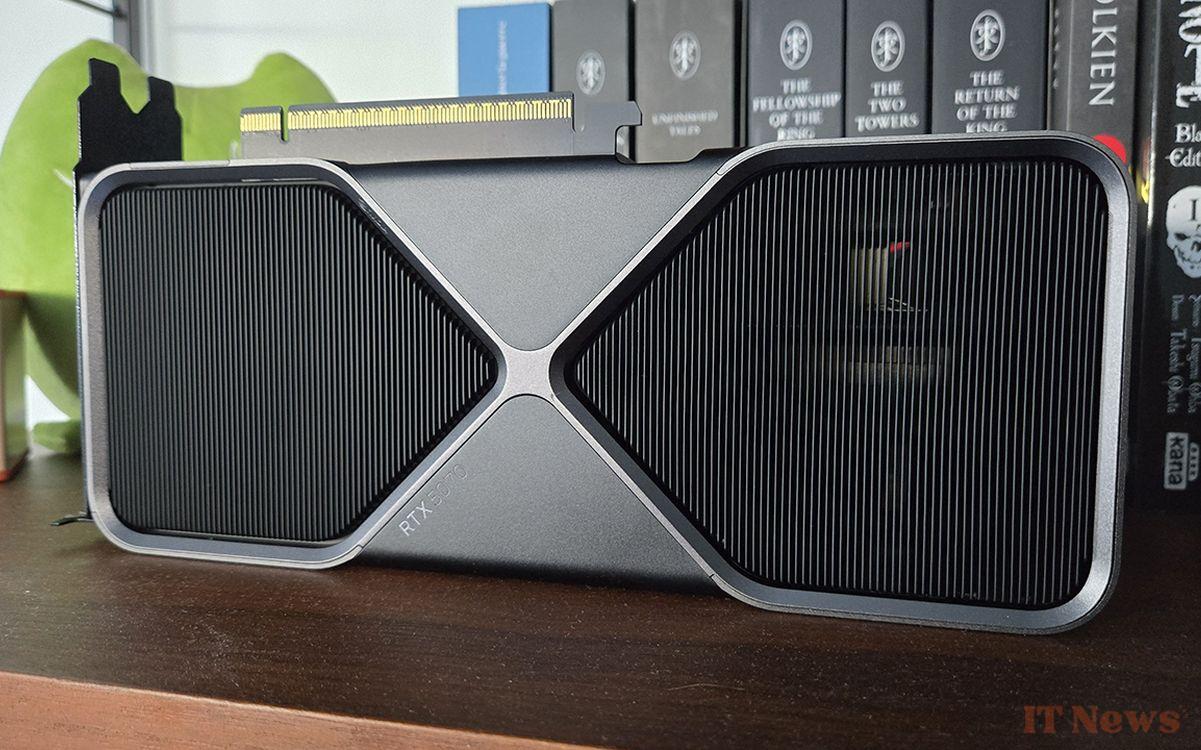


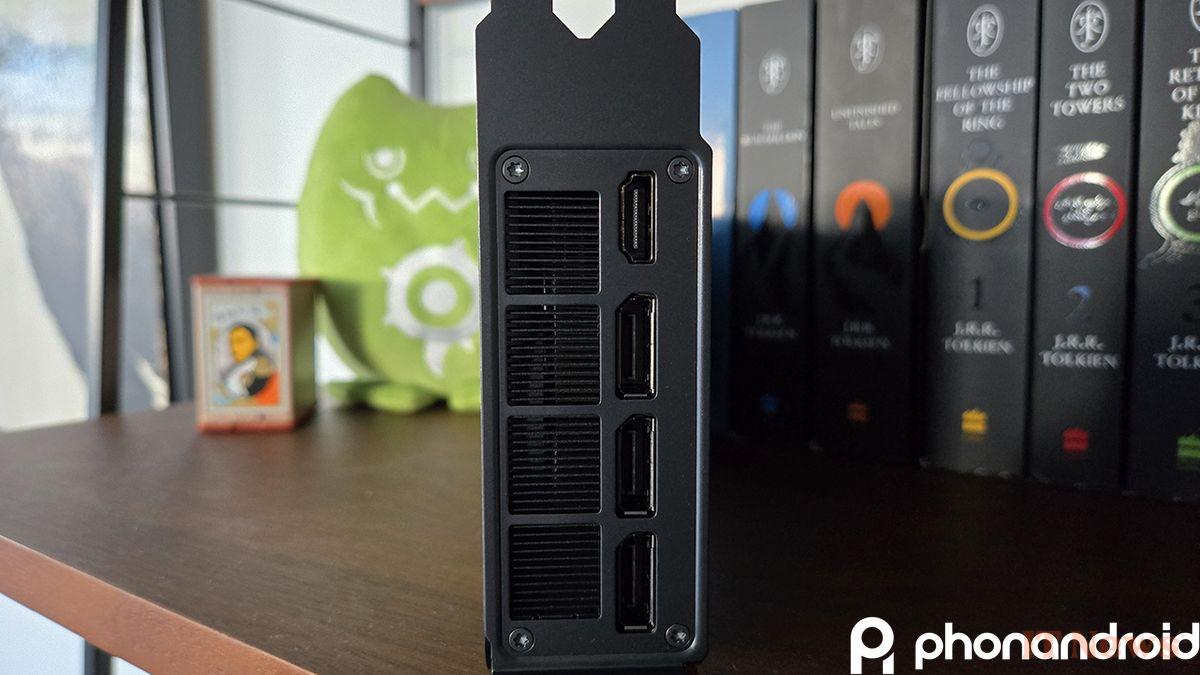
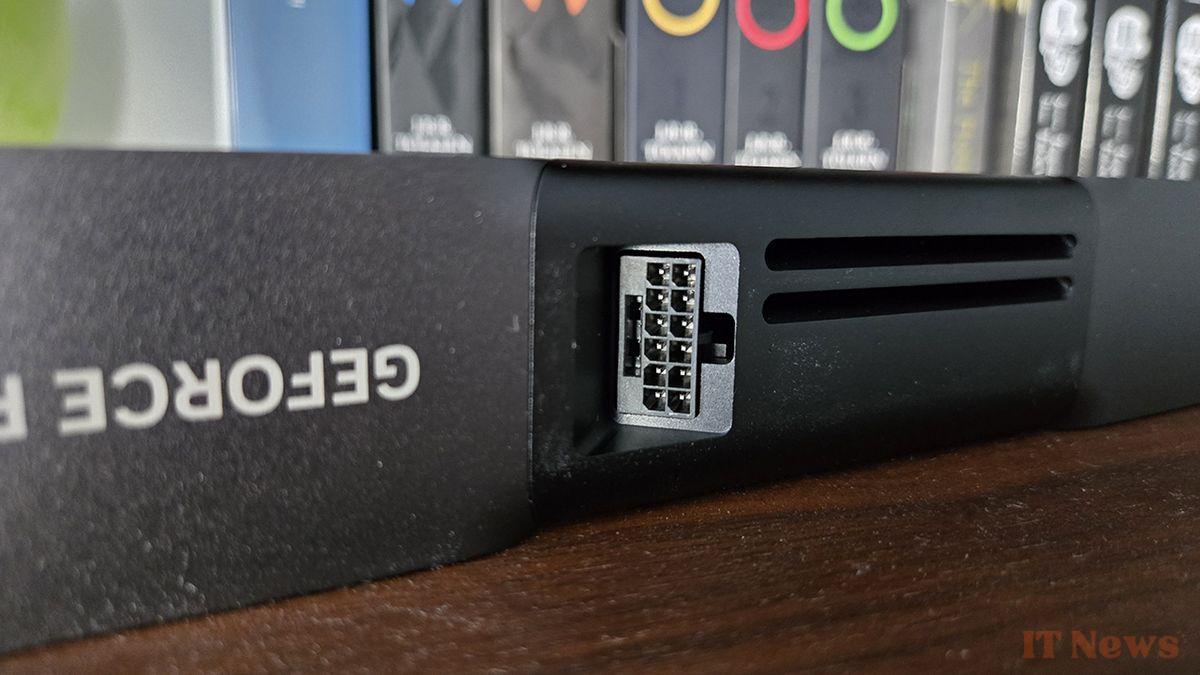
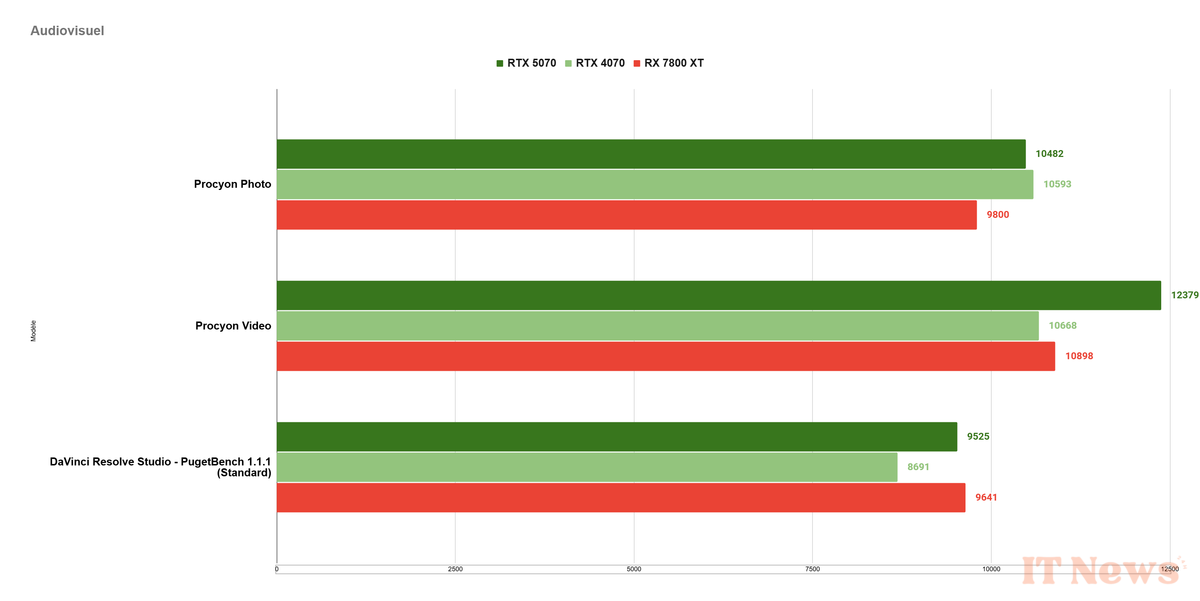
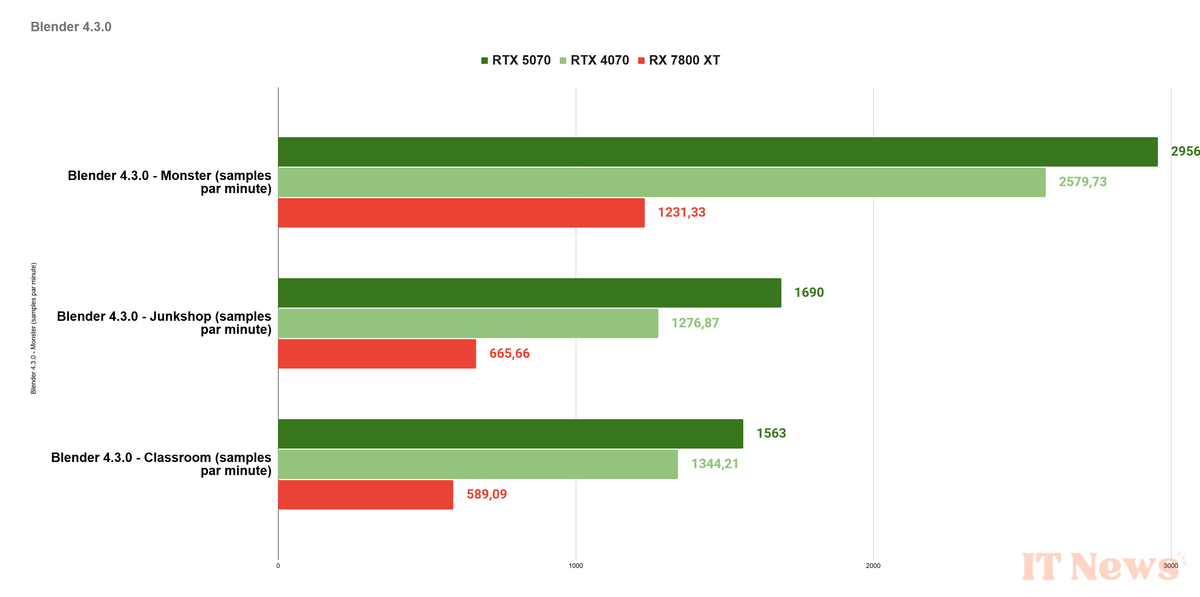
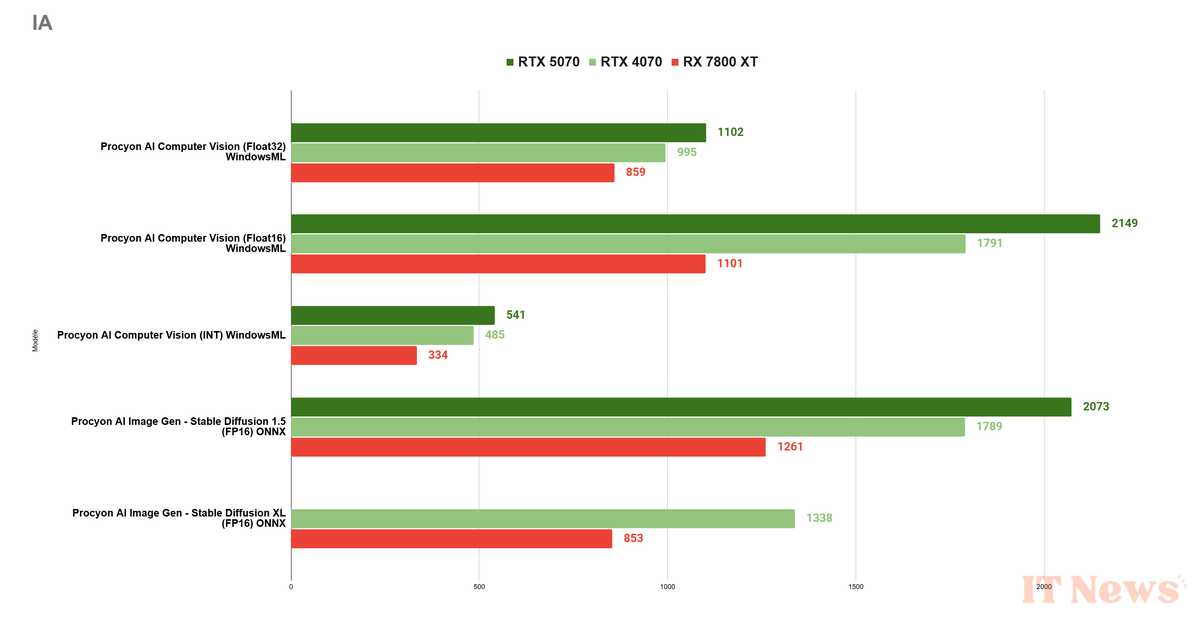
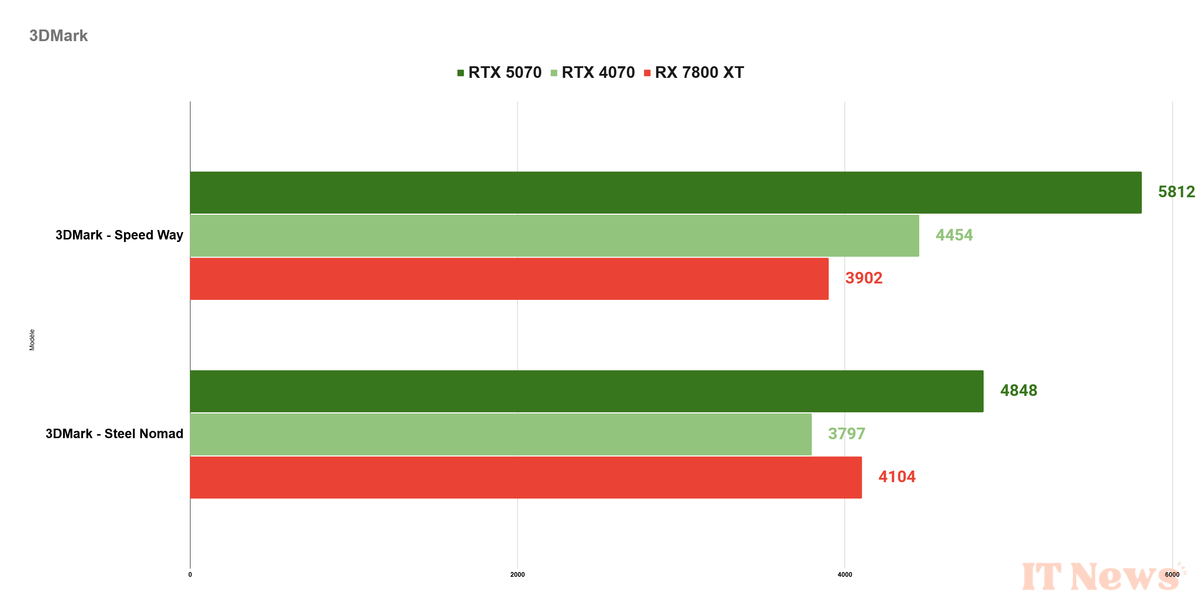

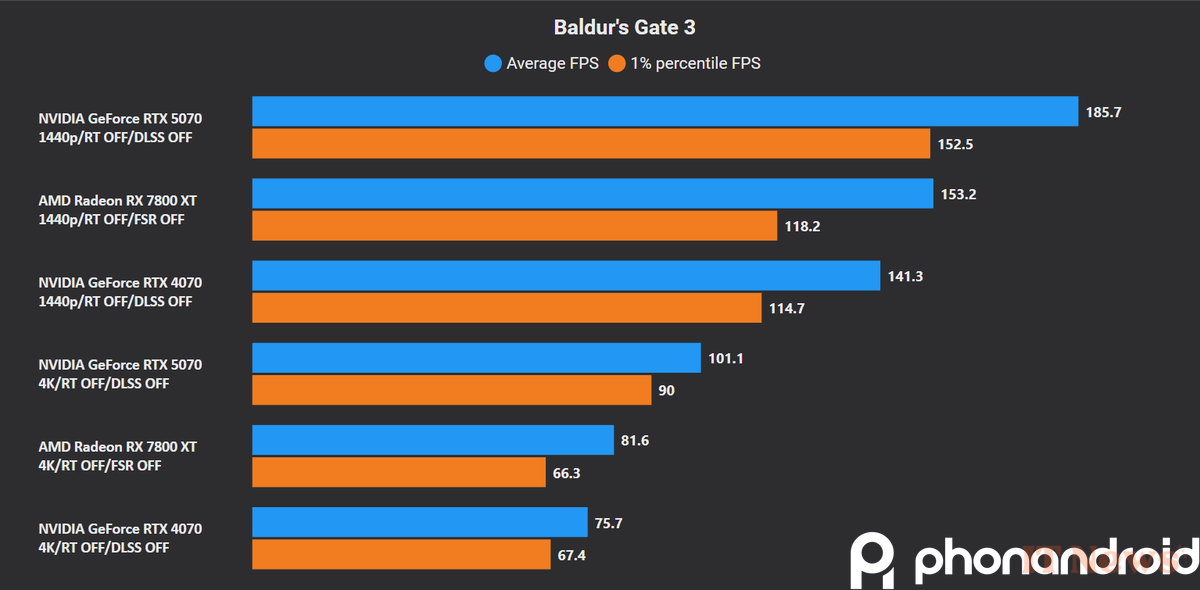
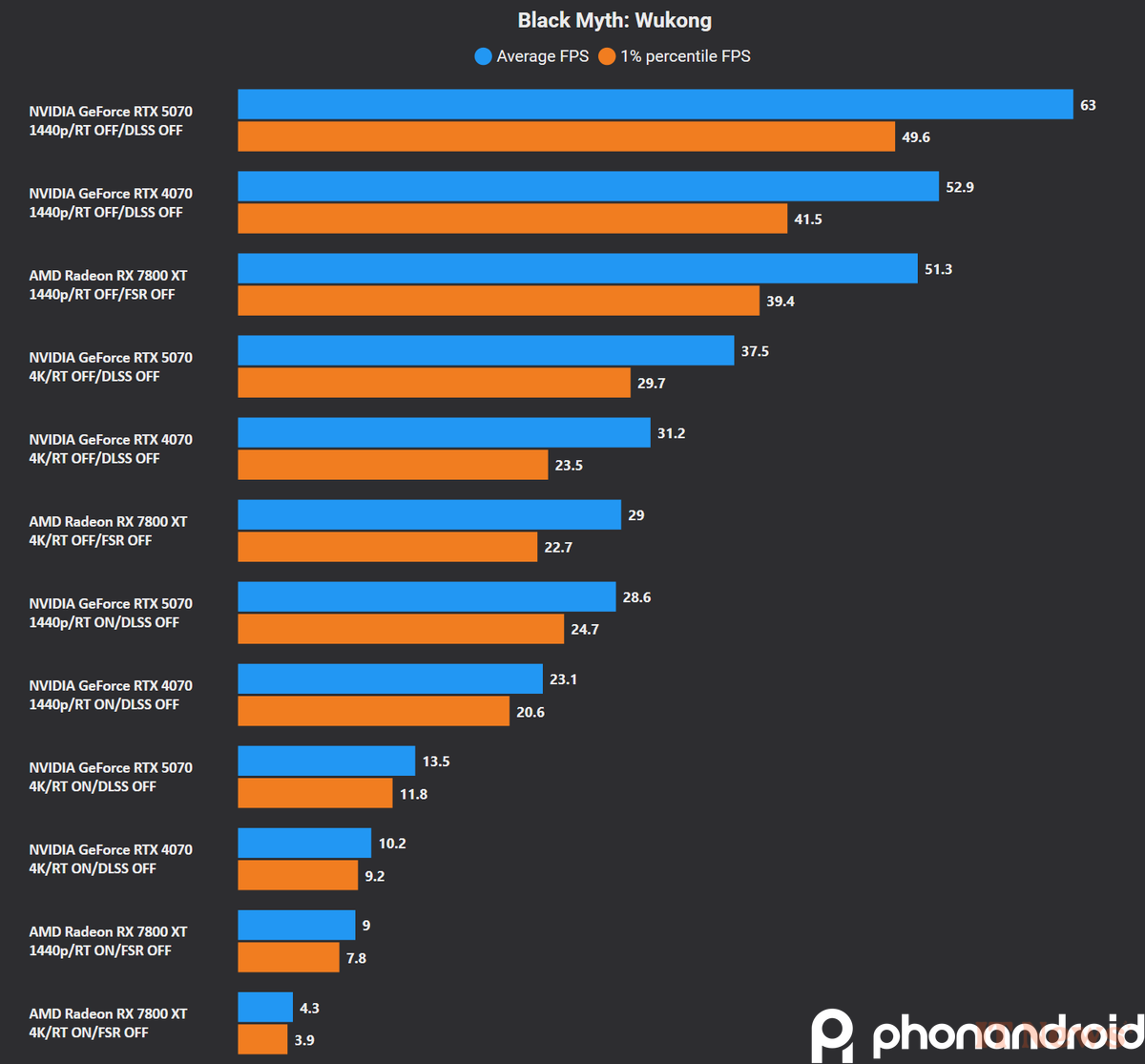
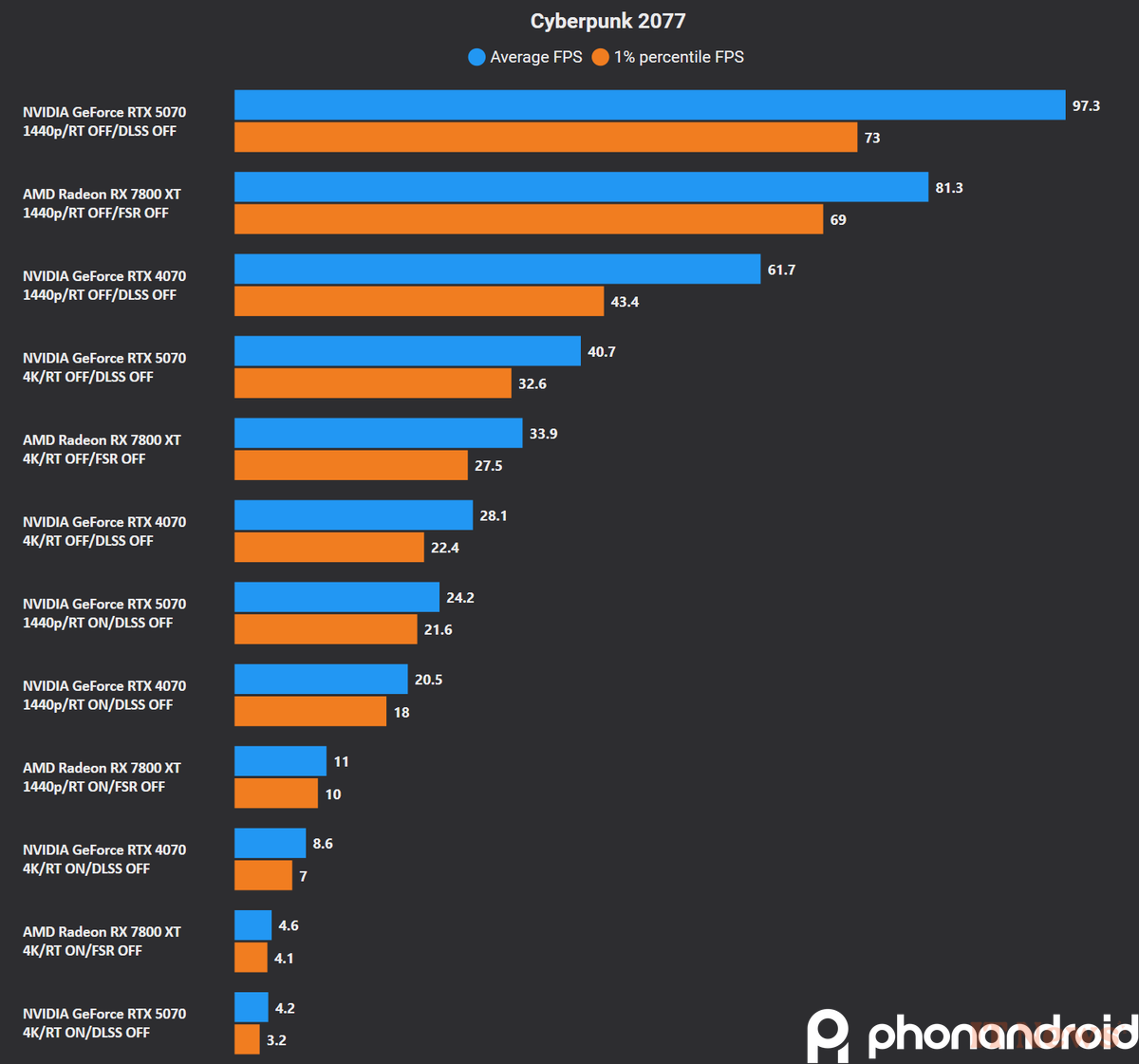
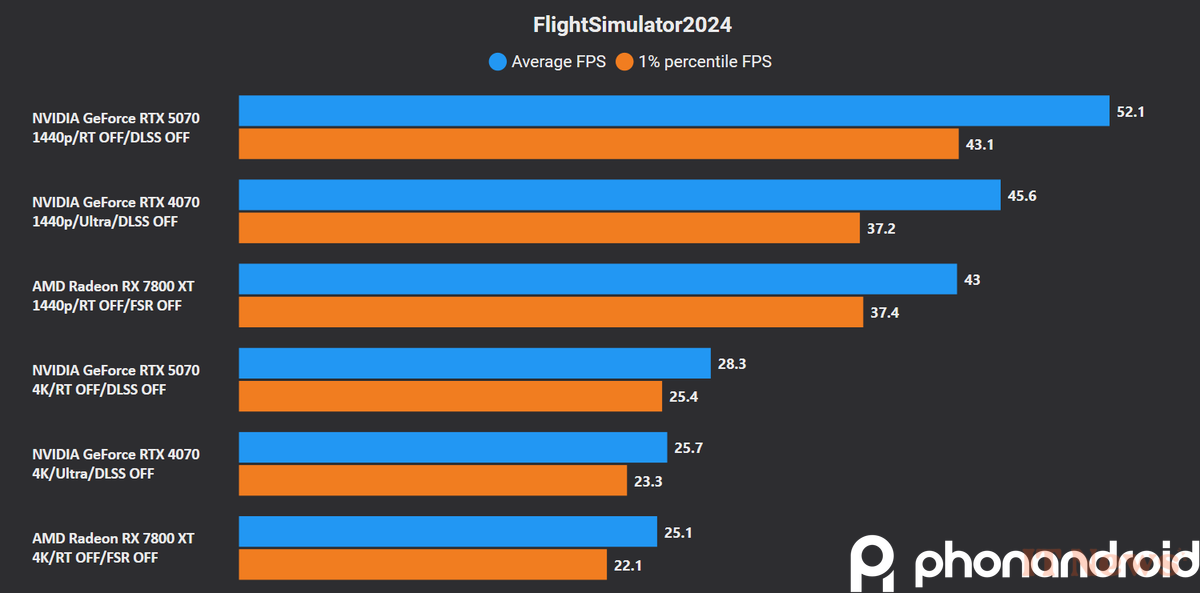
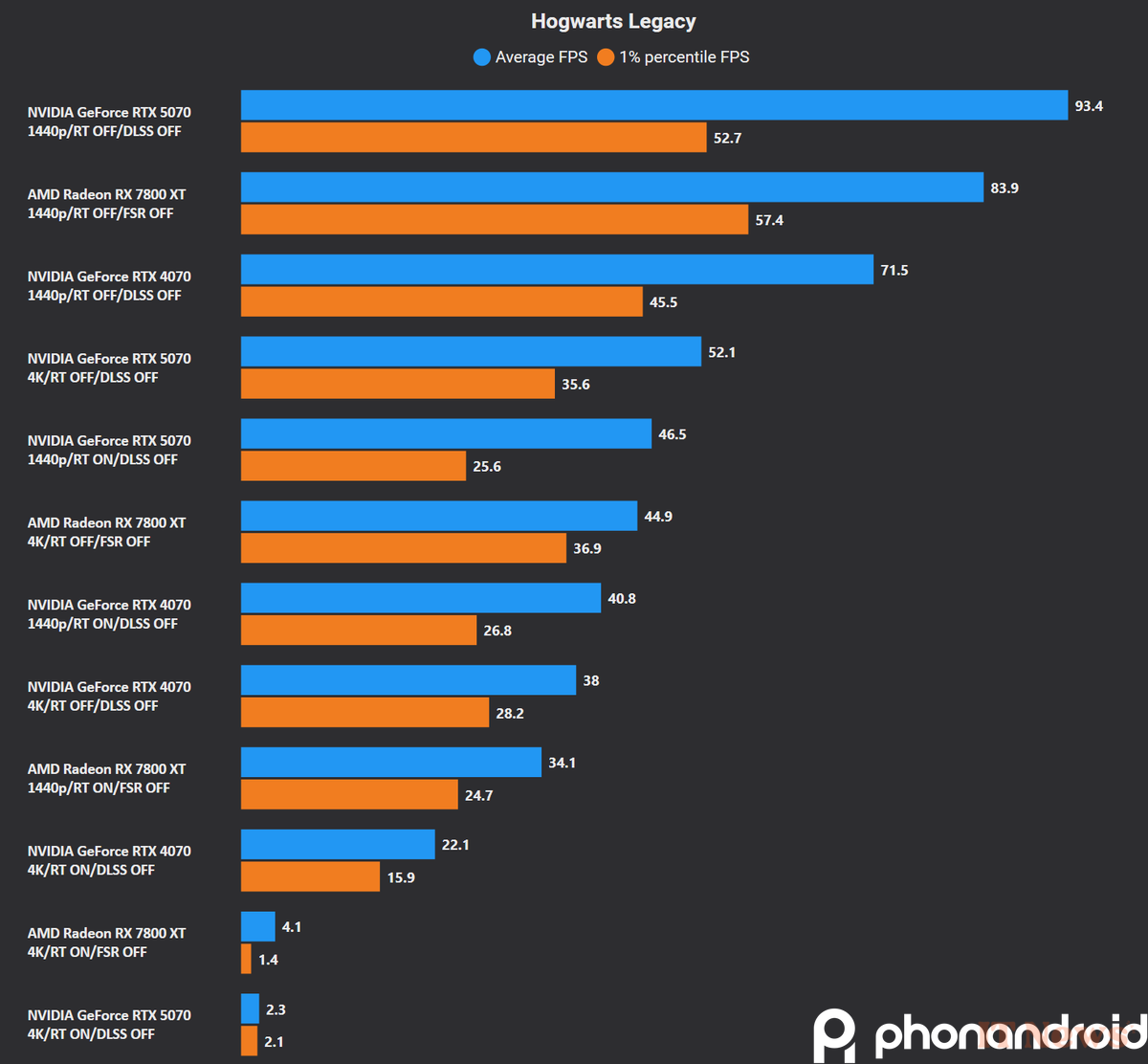
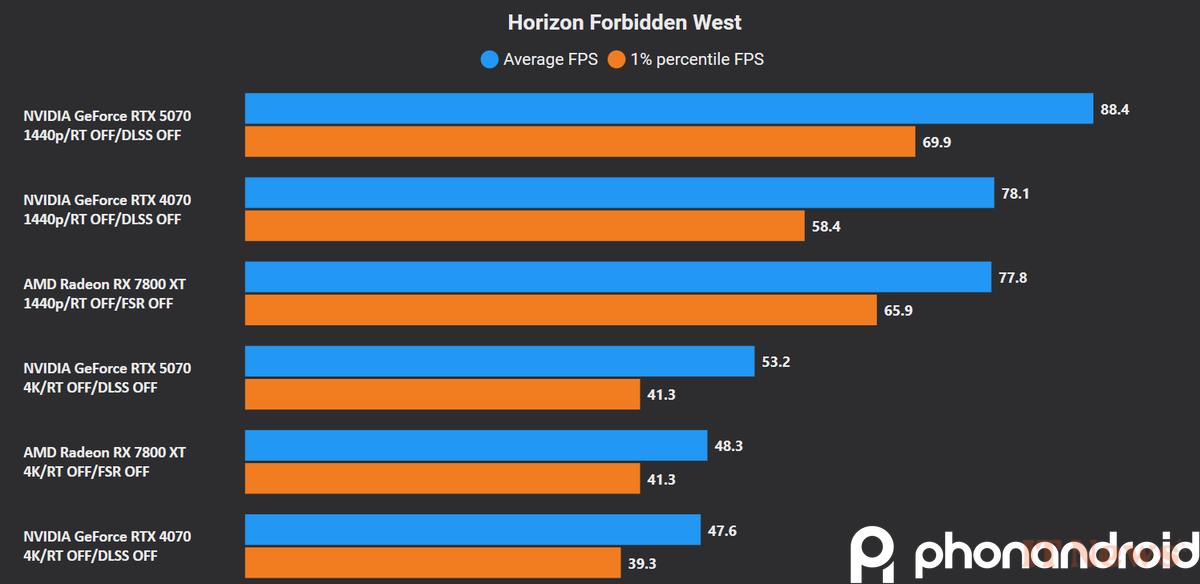
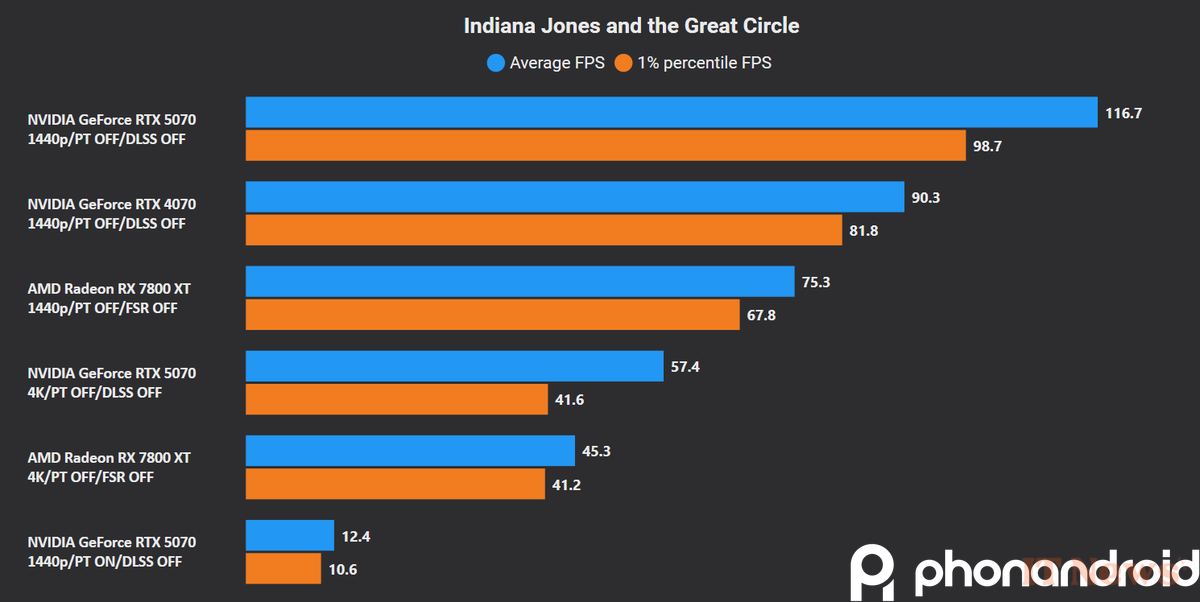

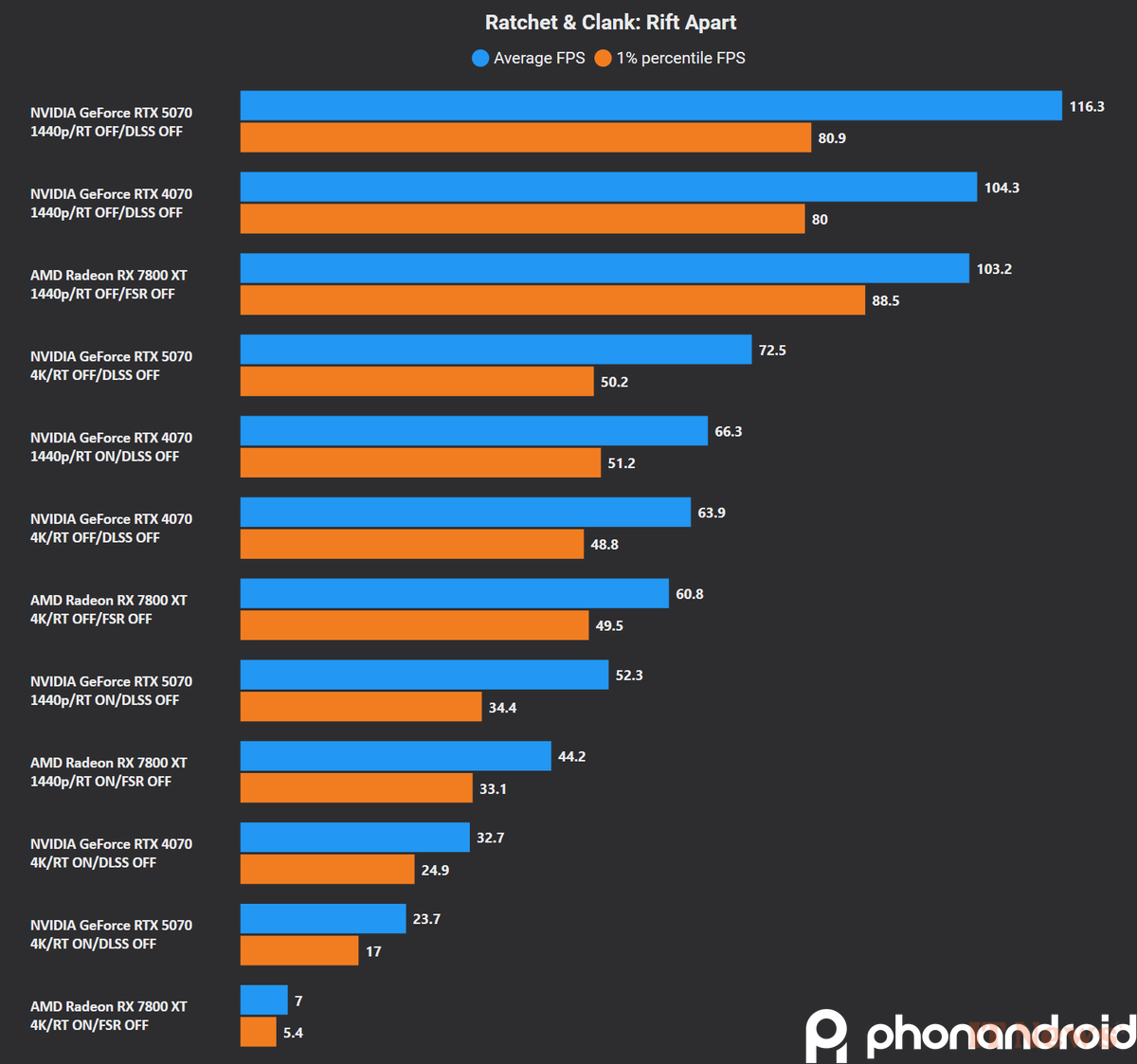
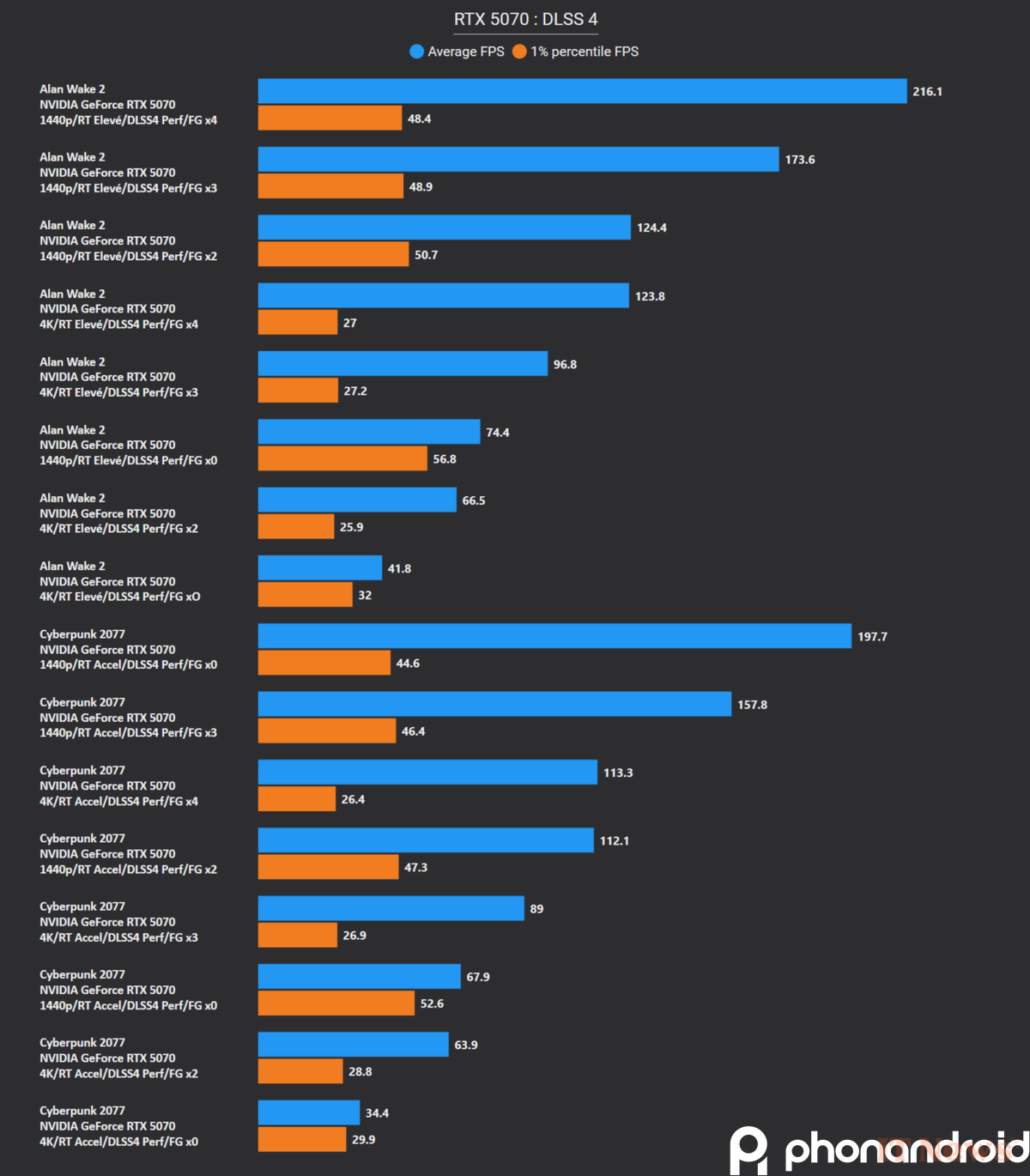
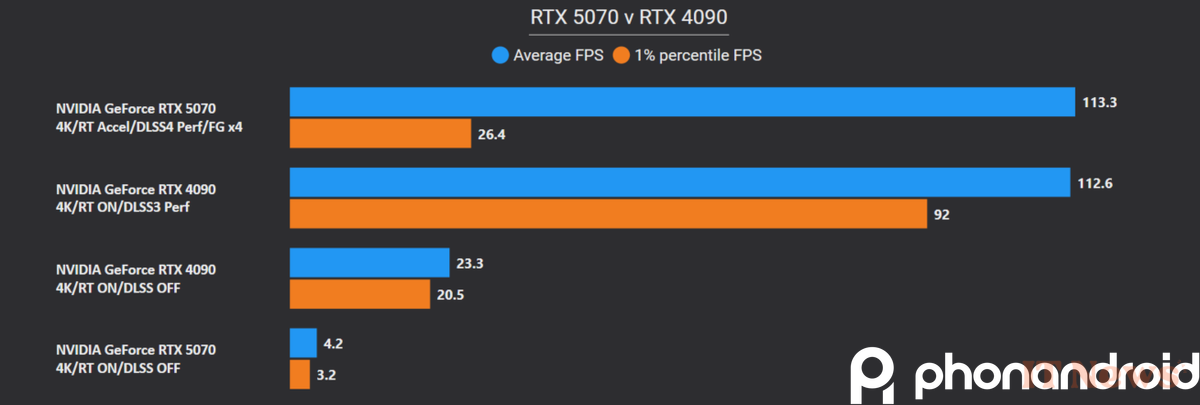

0 Comments